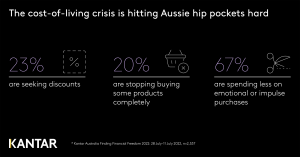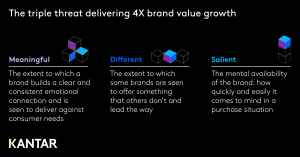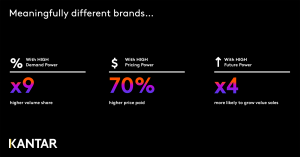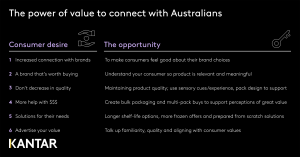
The price of value in inflationary times
Every brand needs to understand the anatomy of the value they offer their customers – most importantly, that it doesn’t always equal price. Value is a measure of worth, which is not necessarily monetary. It is closely tied to our intrinsic values that guide our attitudes and actions.
Our Kantar Sustainability Sector Index reveals that mental health is Australia’s single most important issue, closely followed by work and economic growth. Yet, as inflation continues to overwhelmingly impact how we live and shop, our Finding Financial Freedom study is also very telling – four in five of us are feeling the pain every day as interest rates, and petrol, energy and grocery prices soar, all rubbing a deeper hole in our hip pockets. And this tsunami is placing more pressure on our values and the value we seek from brands.

So, how does your brand create value while supporting Aussie shoppers through another crisis?
Australians are overwhelmingly looking to brands to help and support us through this cost-of-living crisis, just as they did through the pandemic. But as brands dealing with supply chain challenges, rising operating costs and the need to safeguard profits, how can you maintain your pricing power when price reductions are at the top of consumer the shopping list? It is all about balancing pricing power with consumer value.
Pricing power is the ability to justify a price premium relative to the category average. It reflects people’s willingness to pay more for a product or service, and unwillingness to substitute it. We measure this through Kantar’s Meaningfully Different Framework, which combines three metrics: meaningfulness, difference and salience. When a brand has all three attributes, it has the power to capture significantly more volume, can command pricing power, and has much greater potential to gain value share. In fact, Kantar BrandZ data shows that strongly meaningful, different and salient brands have four times the commercial brand value growth of those who aren’t.

In fact, our global validations also show a proven link between pricing power and increased brand revenue, margins and profits. People are prepared to pay double for some products with high pricing power. Even bargain hunters are willing to pay 14 per cent more for the brands they consider to be meaningfully different. But we’re not all necessarily looking to reduce costs in every aspect of our lives. As we prioritise our values, the brands most meaningful and different to us will resonate most.
Any brand – old or new – can increase its brand value by understanding what makes it different, but also by being meaningful and salient. The Kantar BrandZ Most Valuable Australian Brands 2023 report reveals that existing and new customers are rewarding Australian brands that are both meaningful and salient. When brands achieve meaningful salience, they are well known for something that consumers feel is relevant to their lives and tend to grow market share as a result. As people become more discerning with their spend, brands can stand out from the crowd is by providing a product or experience that’s tailored to the individual.
Brands with powerful mental and physical connections leverage their equity to create value faster
These brands also resist market downturns and recover sooner from them. On average, brands with high pricing power can charge more. Consumers pay twice the price for the brands with high pricing power, compared with low. And while price is set by brand owners and retailers; consumers, on average, pay a higher price for brands with stronger equity.

Kantar’s Global Thought Leader for Brand Mary Kyriakidi, says “It’s not a contradiction; brands can maintain their pricing power in ways that are also affordable to consumers. By focusing on your brand as a value producing asset, you align your interests to those of the consumers. Because consumer choice will always tilt towards brands that are meaningfully different, both now and in the future.”
Maximising value is essential in these times because great value is what buyers are looking for
As I said upfront – value doesn’t always equate to price. Ultimately, it is the measure of importance. Australians are increasingly looking to brands to help and support them through this cost-of-living crisis – so as brands and retailers, you must increase your meaningfulness to help to strengthen your connection with consumers. Also be aware that current economic challenges have the potential to change the way Australians buy and consume products and services.
As my colleague, Kantar Australia’s Head of Qualitative Carolyn Reid says, “cost-of-living is now the great human unifier. And in this period of economic turmoil, your brand has a real chance to help Australians to unlock their mental wealth, build self-esteem, and increase the value exchange.” Our expectations of brands are also evolving around social and environmental sustainability commitments and actions. Kantar BrandZ data shows that sustainability credentials can drive a meaningful difference, and that drives choice.
So, to optimise the price of value in today’s inflationary environment, communicate your price advantage over competitors and emphasise your ‘social proof’ of quality and value. In retailer negotiations, consider larger pack formats; establish ground for future premium range extensions and advertise your value – familiarity, quality and aligning with consumer values. And add value to differentiate from commodities, focusing on quality and the consumption experience.


Sara Mawhinney
Head of Sensory,
Australia, Kantar
This article was first published in Retail World June 2023


